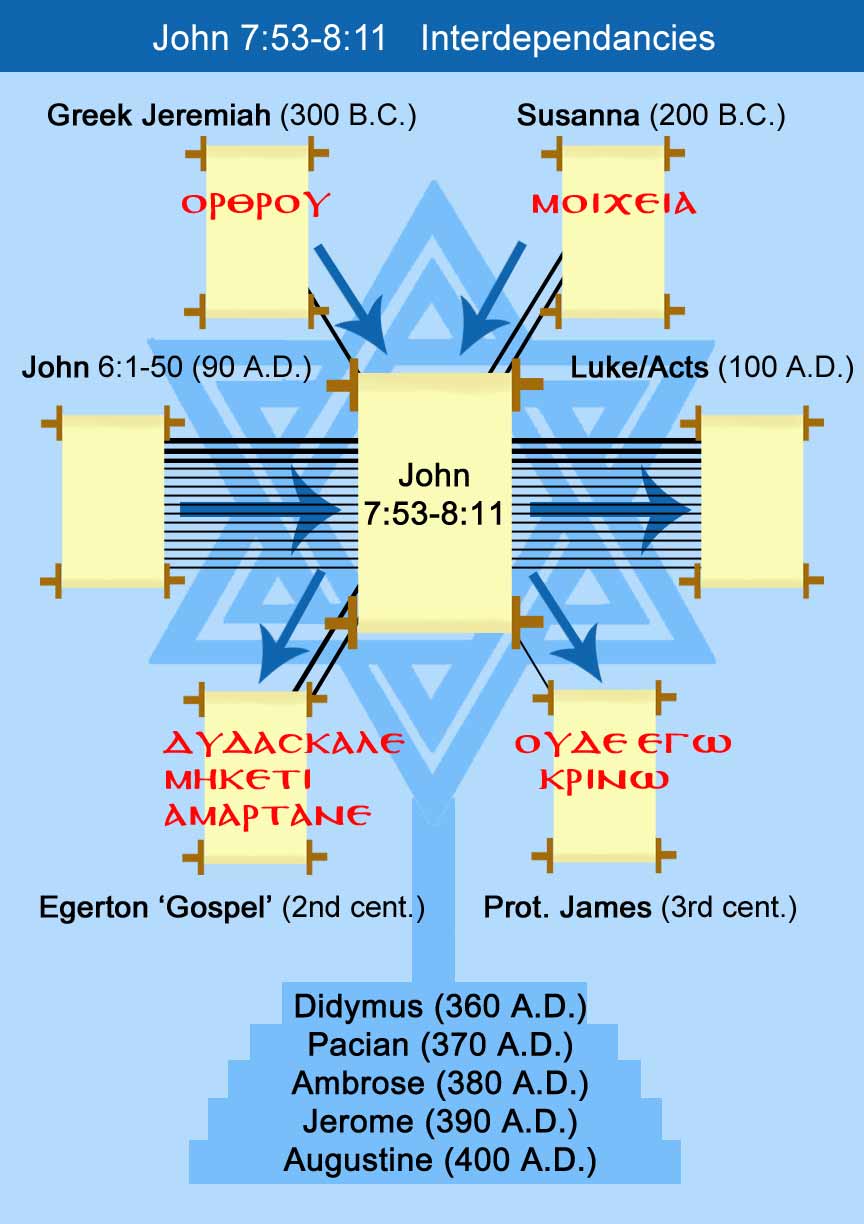INTRODUCTION
Background
Recently, various non-canonical (extra-biblical) documents have been considered as sources of material appearing in NT books. More plausibly, these obscure documents have been examined as possible evidence for the early existance of controversial passages or readings among the extant NT manuscripts.
Of special interest to us are the Egerton 'fragments of an unknown gospel', which on analysis turn out to be composite documents created by blending snippets of canonical gospels together.
It has already been recognised that these early fragments are probably also early evidence for the existance and popularity of John's gospel.
A website dedicated to the Egerton Fragments can be found here, which presents a large portion of research and analysis by Skeat and others along with photos of the fragments:
Overview of Intertextual Connections for John 8:1-11
John 8:1-11 has already been connected to more ancient documents, like the Greek Jeremiah and the story of Susanna. Recently, we have shown its close dependance upon John chapter 6:
Culpepper on John 8:1-11 <-- Click here for Connections to John 6.
Others such as Zervos have tried to show either a connection or an interdependancy upon the Protevangelion of James.
But more convincing at least for some kind of connection has been the evidence of Cadbury:
Cadbury on John 8:1-11 and Luke <-- Click here for Connections to Luke.

But rather than make difficult or implausible claims about the dependancy of our passage (John 8:1-11) upon other, later documents, we only want to make the more modest observation of a possible dependancy in the other direction, namely that the Egerton Fragment shows some knowledge of our passage.
In this case, the evidence, although weak, is about twice as strong as the evidence of a link between John 8:1-11 and the Protevangelion of James.
Egerton Gospel & John 8:1-11
Egerton 'Gospel' - Earliest textual evidence for Jn 8:1-11?
After nearly a century of intense study of the Egerton 'Gospel' fragments, the dust has pretty much settled about the actual nature of the document.
It is probably not an unknown '5th gospel', but rather an interesting piece of creative writing, a 'harmony' of sorts of at least three canonical gospels (possibly by a student, or practicing writer/preacher).
It is now virtually admitted that the 'author' used canonical John among other documents (and not vice versa for instance), based upon the nature of the internal evidence in the document.
This has made the Egerton papyrus perhaps one of the earliest significant textual witnesses to the existance and circulation of the Gospel of John.
However, the use of John being reasonably settled, little thought has apparently been spent upon its possible importance as a witness to the early existance (and location in John) of the Pericope de Adultera.
Admittedly, the evidence is very slender and tentative. But it is a remarkable coincidence, that several phrases are placed in close proximity, in the correct order (the same as in the Pericope), namely,
"rulers...the crowd..."
"Teacher! (διδασκαλε = 'rabbi', see Jn 3:2)" ...
"Go...and sin no more!"(μηκετι αμαρτανε)
In particular, the combination of "Teacher"...(cf. Jn 8:4) and "Sin no more" (Jn 8:11) are eerily reminiscent of the Pericope de Adultera. 1

But if we admit that the Egerton author had John in front of him already, the next question might be, not that he himself connected the conversation of Nicodemus ("Rabbi" Jn 3:2) with that of the cripple in Judea ("Sin no more" Jn 5:14), but rather,
"Did the Egerton author use the Pericope de Adultera as an enclosing template for his Leper story?"
Note especially that in John's Gospel Nicodemus uses the word 'Rabbi', not 'Didaskale', and so Jn 3:2 is less plausible as the source for the 1st statement in the Egerton fragment.
This 2nd century 'harmonizer' uses 'Didaskale' elsewhere as well, making it into a kind of trademark for the Egerton work, so this is perhaps not so unusual in itself. Yet...
Whatever may be said of the 'softness' of the connection, it must be admitted that the only place in the Entire New Testament, and even among the hundreds of non-canonical 'gospels', where these two phrases come together in this order in close proximity, is
the Pericope de Adultera, John 8:1-11.
Modern Footnotes
Footnotes courtesy of Nazaroo:
1. Although the two fragments of this page have been torn apart (deliberately?), the identity of the fragments as being from the same page is not in serious dispute. See the Egerton Website for details and documentation of the handling and identification of the fragments.